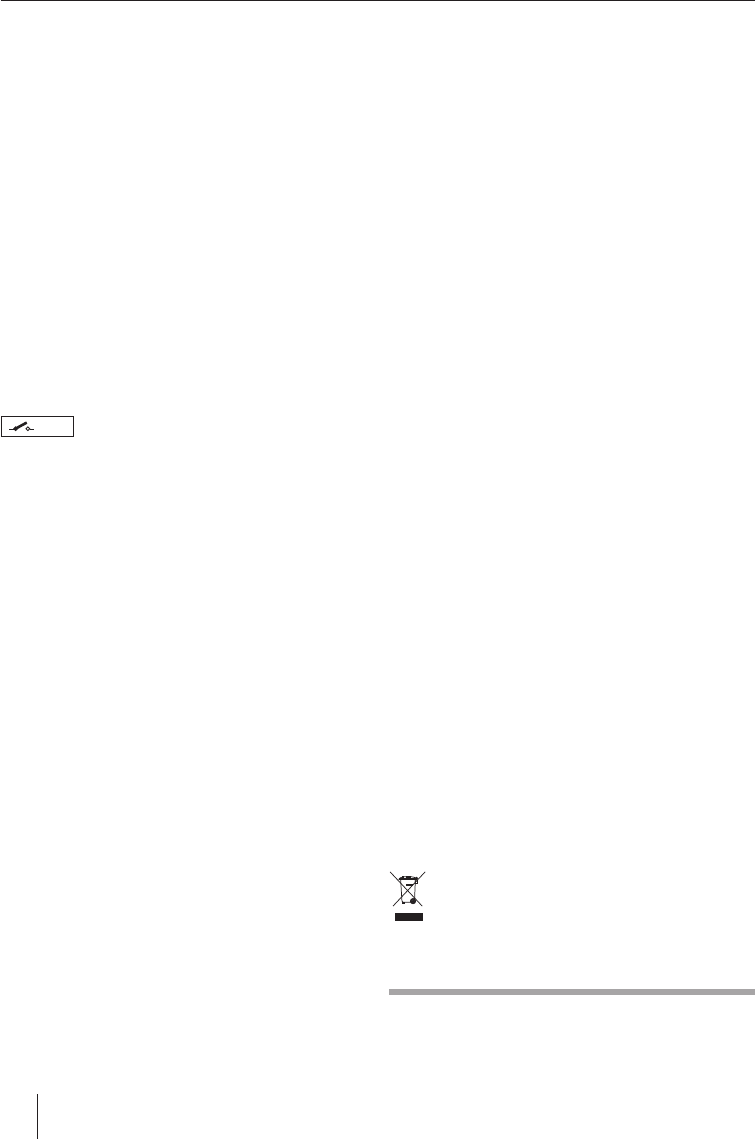
EMA 255
6
Plus / minus connection
We recommend a minimum cross section of 6 mm
2
.
Route commercially available plus cables to the battery
and connect via fuse holder.
Use cable glands for holes with sharp edges.
Securely fasten commercially available minus cables to a
noise-free earth point (chassis screw, chassis metal) (not
to the minus pole of the battery).
Scrap the contact surfaces of the earth point until they
are bright and grease with graphite grease.
Integrated fuses (Fuse)
The fuses integrated in the ampli er (Fuse) protect the power
ampli er and the entire electrical system in case of an error.
If a replacement fuse is used, never bridge fuses or replace
them with a type with higher current.
Connection examples
Connection of the voltage supply ...............................Fig. 2
Audio inputs .......................................................................Fig. 3
Loudspeaker connections .............................................Fig. 4/5/6
+12V
Remote connection of the ampli er with switchable +12 V
voltage source.
This allows the ampli er to be switched on and o using the
on/o -switch of the radio device.
Level control
The Level control is used to adjust the input sensitivity of
the power ampli er to the output voltage of your car sound
system preampli er output.
The adjustment range is from 0.2 V to 10 V.
If a car sound system of a third party manufacturer is con-
nected, the input sensitivity must be adjusted corresponding
to the manufacturer data.
A few important explanations in this context:
By turning the control clockwise, the input sensitivity of the
ampli er and, therefore, also the volume increases. However,
this is not a volume control; no further ampli er output
can be achieved in the end position, even if it may sound
like that at the beginning. The system merely increases the
volume faster if the volume control of the car sound system
is turned up.
Loudspeaker connections
(If the ampli er is to be jumpered, continue with the section
"Bridged loudspeaker connections" at this point).
As with every audio component, the correct polarisation of
ampli er and loudspeakers is of essentially importance for a
good bass response. For this reason, ensure that the positive
(+) connection of the ampli er is connected with the posi-
tive connection (+) of the loudspeaker; the same applies to
the negative (-) connections. In addition, the left ampli er
channel must be connected with the left loudspeaker and
the right ampli er channel with the right loudspeaker.
–
–
–
–
–
Bridged loudspeaker connections
The EMA ampli er can also be bridged for a mono con gura-
tion. This allows the ampli er to be used for one or several
subwoofers or mid-range drivers. In this con guration, the
ampli er combines the right and left channel to a single-
channel output (mono output).
Note:
The ampli er can add the right and left signal information
only if the right as well as the left RCA connection were
carried out.
Caution:
In a bridge circuit, the ampli er load must be 4 ohm or
higher. A lower load leads to an overheating or switch-o
of the ampli er and can cause permanent damages.
Adjusting the type and range of the
frequency crossovers
With the EMA 255, the type of frequency crossover (i.e. "Low
Pass" or "Hi-Pass") and the desired entry frequency can be
adjusted. For example, if a pair of subwoofers is to be con-
nected, the low-pass settings shown are required (Fig. 3). The
entry frequency is dependent upon the frequency range of
the loudspeakers (see recommended frequency range of
the loudspeakers).
High-Pass
At a setting of 80 Hz, the ampli er has a frequency range of
80 Hz to 30,000 Hz.
Low-pass frequency control
This control is active if the switch is in the position "Low-Pass",
and allows for setting the desired entry frequency.
Example:
At a setting of 150 Hz, the ampli er has a frequency range
of 10 Hz to 150 Hz.
Bass boost
The bass boost control is used to adjust the bass response
of the ampli er.
The setting options are: 0 dB / +6 dB / +12 dB.
Power-on indicator (PWR / PRO)
Green LED:
Output stage on, regular operating status.
Red LED:
Output stage is electronically switched o due to an error.
Recycling and disposal
Please use the return and collection systems avail-
able to dispose of the product.
Subject to changes
EMA_255_22LG.indd 6EMA_255_22LG.indd 6 29.07.2011 9:15:52 Uhr29.07.2011 9:15:52 Uhr


















